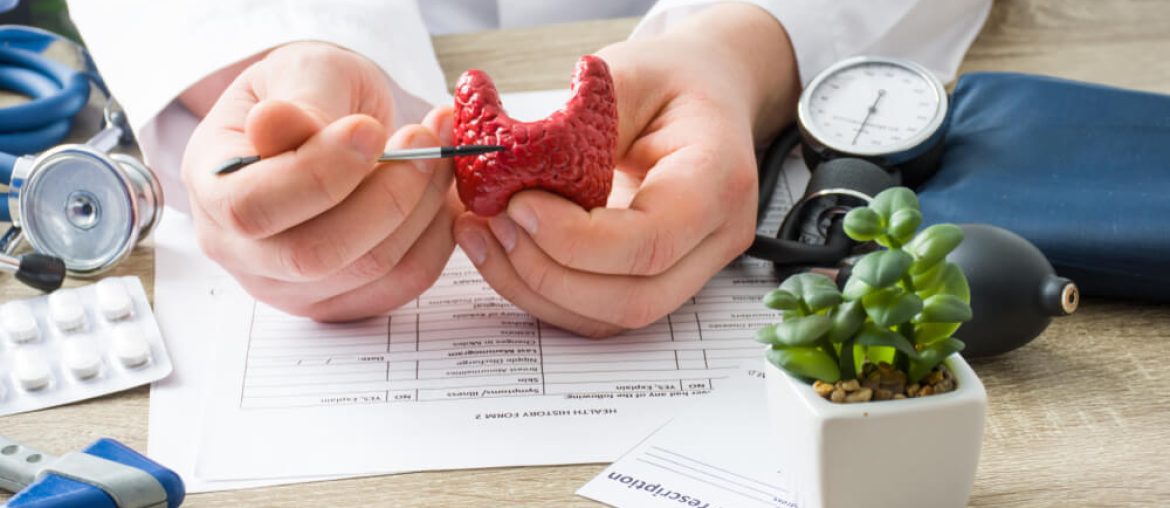What is Thyroid Disease?
The thyroid gland is located at the base of your neck in front of your trachea (or windpipe). The thyroid gland makes, stores, and releases two hormones – T4 (thyroxine) and T3 (triiodothyronine). Certain disorders can cause the thyroid gland to make too much or too little hormone. Women at risk of thyroid disease include those who have or have had an autoimmune disease (such as diabetes).
What is the Function of the Thyroid Gland?
Thyroid hormones control your metabolism, which is the rate at which every part of your body works. When your thyroid gland is working the way it should, your metabolism stays at a steady pace—not too fast or not too slow.
The thyroid gland is controlled by the pituitary gland (a gland in your brain). The pituitary gland makes thyroid-stimulating hormone (TSH). TSH tells the thyroid gland to make more hormone if needed.
How is Thyroid Disease Diagnosed?
Thyroid disease is diagnosed by your symptoms, an exam, and tests. Symptoms of thyroid disease can be much like symptoms of other health problems.
Your health care provider will examine your neck while you swallow. The thyroid gland moves when you swallow. This makes it easier for your health care provider to feel. Your health care provider also may examine your skin and eyes and check your weight and temperature.
What Tests are Used to Diagnose Thyroid Problems?
The following tests may be used to help find the exact cause of a thyroid problem:
- Blood tests
- Ultrasound exam of the thyroid
- Thyroid scan
During a thyroid scan, you drink a small amount of radioactive iodine. A special camera then detects the areas of the thyroid gland that absorb the radioactive iodine. Results of this test show areas of the thyroid gland that are underactive or overactive. This test will not be done if you are pregnant.
What is Hypothyroidism?
Hypothyroidism occurs when the thyroid gland does not make enough of the thyroid hormones to maintain your normal body metabolism.
What Causes Hypothyroidism?
The most common cause of hypothyroidism is a disorder known as thyroiditis – an inflammation of the thyroid gland. The most common type of thyroiditis is called Hashimoto disease. In this disease, the immune system – your body’s natural defense against disease – mistakes cells in the thyroid gland for harmful invaders. Your body sends out white blood cells to destroy the thyroid gland. The pituitary gland then releases TSH to tell the thyroid gland to make more thyroid hormone. This demand on the thyroid gland can cause it to enlarge. This enlargement is called a goiter. Hypothyroidism also can result from a diet that does not have enough iodine, although this type of hypothyroidism is rare in the United States.
What are the Symptoms of Hypothyroidism?
The symptoms of hypothyroidism are slow to develop. Common symptoms of hypothyroidism include the following:
- Fatigue or weakness
- Weight gain
- Decreased appetite
- Change in menstrual periods
- Loss of sex drive
- Feeling cold when others do not
- Constipation
- Muscle aches
- Puffiness around the eyes
- Brittle nails
- Hair loss
What Treatment is Available for Hypothyroidism?
In most cases, hypothyroidism is treated with medication that contains thyroid hormone. The dosage of the medication is increased slowly until a normal level of thyroid hormone has been reached in the blood.
What is Hyperthyroidism?
Hyperthyroidism results when the thyroid gland makes too much thyroid hormone. This causes your metabolism to speed up.
What are the Causes of Hyperthyroidism?
The most common cause of hyperthyroidism is a disorder known as Graves disease. It most often affects women between the ages of 20 years and 40 years. A late sign of Graves disease is often a wide-eyed stare or bulging eyes.
Hyperthyroidism also may result from medication. Taking too much thyroid hormone when being treated for hypothyroidism can lead to symptoms of an overactive thyroid. Lumps in the thyroid called hot nodules are another cause. These lumps produce excess thyroid hormone.
What are the Symptoms of Hyperthyroidism?
Common symptoms of hyperthyroidism include the following:
- Fatigue
- Weight loss
- Nervousness
- Rapid heartbeat
- Increased sweating
- Feeling hot when others do not
- Changes in menstrual periods
- More frequent bowel movements
- Tremors
What Treatment is Available for Hyperthyroidism?
Anti-thyroid medication can be used to reduce the amount of thyroid hormone your body is making. Medications are known as beta-blockers control rapid heartbeat.
If these medications do not help, your health care provider may suggest treatment with high-dose radioactive iodine to destroy parts of the thyroid gland. In some cases, surgery may be needed to remove the thyroid gland.
What are Thyroid Nodules?
A nodule is a lump in the thyroid gland. When a thyroid nodule is found, it will be checked to see if it is benign (not cancer) or malignant (cancer).
Your health care provider may use ultrasound to examine the nodule. Nodules may be further examined by a procedure known as fine needle aspiration or biopsy.
If no cancer cells are found, your health care provider may either prescribe medication to decrease the size of your nodule or suggest surgery to remove it. If cancer cells are found, further treatment will be needed. Thyroid cancer usually can be treated with success.
Can I Be Treated for Thyroid Disease if I am Pregnant?
Many medications used to treat thyroid disease in pregnancy are safe for your unborn child. However, your health care provider may monitor you closely while you are being treated. Radioactive iodine, which is sometimes used to treat hyperthyroidism, cannot be taken during pregnancy. It may injure the thyroid gland of the fetus and may cause the baby to have hypothyroidism.
What is Postpartum Thyroiditis?
Some women may not have thyroid problems during pregnancy, but develop problems after childbirth. This condition is called postpartum thyroiditis. It often is a short-term problem and hormone levels quickly return to normal.
Is Regular Screening Recommended for Thyroid Disease?
Regular screening for thyroid disease should be done every 5 years beginning at age 50 years. Women at risk may need to be screened earlier or more often.


















